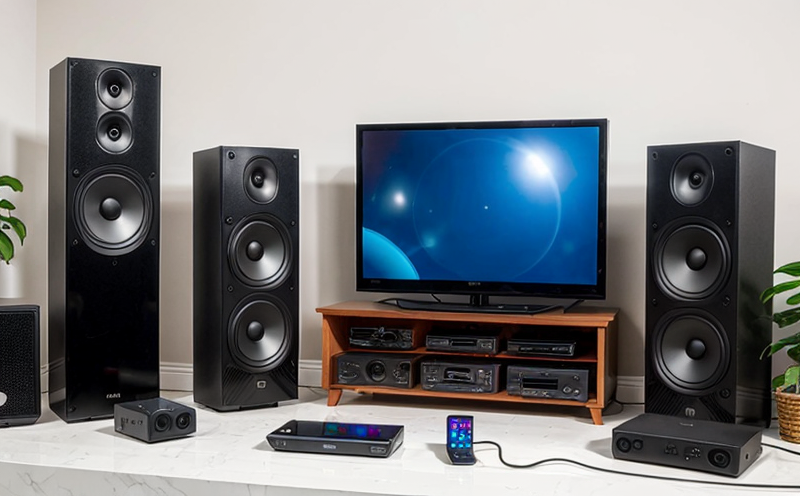EN 301 489 EMC Testing for Wireless Consumer Devices
The European standard EN 301 489 specifies limits and methods of measurement to ensure that wireless devices operate without causing harmful electromagnetic interference (EMI) in their environment. This is particularly critical for consumer electronics, as it ensures compatibility with existing networks and devices while maintaining high levels of quality and safety.
The standard covers a wide range of wireless devices including mobile phones, tablets, Bluetooth headsets, and Wi-Fi routers, among others. It aims to protect consumers from potential health risks associated with excessive electromagnetic emissions and guarantees that the device functions correctly in various environments.
Compliance with EN 301 489 is mandatory for all wireless devices sold within the European Economic Area (EEA). Failure to comply can result in product recalls, legal action, and damage to a company's reputation. Given this context, it is essential that manufacturers understand the requirements of the standard and have access to reliable testing facilities.
The testing process involves several stages, each critical for ensuring compliance with EN 301 489:
- Preparation Stage: The device must be prepared according to the standard's specifications. This includes ensuring that all components are installed and configured as they would be in a consumer environment.
- Measurement Stage: Electromagnetic emissions are measured using specialized equipment. The measurements cover both the intentional and non-intentional emissions of the device.
- Analysis Stage: The collected data is analyzed to ensure that it meets the limits specified in EN 301 489. This involves comparing the measurement results against the standard's requirements.
- Certification Stage: Once all measurements are within acceptable limits, a certificate of compliance can be issued. This document attests to the fact that the product meets the necessary standards and is safe for use in the EEA.
The importance of this testing cannot be overstated. Not only does it ensure that devices function correctly, but it also protects consumers from potential health risks associated with electromagnetic interference. Additionally, compliance helps manufacturers avoid costly recalls and legal issues. In summary, EN 301 489 is a critical standard for ensuring the safe and effective operation of wireless consumer devices in the EEA.
Why It Matters
The European Union places a high priority on protecting its citizens from potential health risks associated with electromagnetic emissions. By adhering to EN 301 489, manufacturers can demonstrate their commitment to public safety and environmental sustainability. This is especially important for consumer electronics, which are often used in close proximity to the human body.
The standard ensures that wireless devices do not interfere with each other or with other electronic equipment. This is particularly crucial in densely populated areas where multiple devices may be operating simultaneously. By reducing the risk of interference, EN 301 489 helps maintain the integrity and reliability of communication networks.
Furthermore, compliance with this standard can provide a competitive advantage by differentiating products on the market. Consumers are increasingly concerned about the safety and quality of the electronics they purchase. A certificate of compliance from an accredited laboratory can be used as a selling point to reassure potential customers.
Why Choose This Test
Selecting EN 301 489 EMC testing for your wireless consumer devices is not just about meeting regulatory requirements; it's also about ensuring product quality and safety. The test ensures that the device functions correctly in various environments, thereby enhancing user experience.
The standard covers a wide range of parameters including frequency bands, emission levels, and immunity to interference. By testing these parameters, manufacturers can identify any potential issues early in the development process, allowing for timely corrections before product launch.
In addition to ensuring compliance with European regulations, EN 301 489 EMC testing provides valuable insights into the performance of your device under real-world conditions. This information is invaluable for continuous improvement and innovation within the product line.
Competitive Advantage and Market Impact
Compliance with EN 301 489 can significantly enhance a company's competitive position in the market. By demonstrating compliance, manufacturers can build trust with consumers and regulators alike. This is particularly important given the increasing scrutiny of electronic products in terms of both performance and safety.
- Enhanced Reputation: A certificate from an accredited laboratory attests to the quality and safety of your product. This can be a significant differentiator in a crowded market.
- Potential for Innovation: The testing process provides valuable data that can inform future product development and enhance overall performance.
- Avoidance of Legal Issues: Non-compliance with the standard could result in costly legal actions. By ensuring compliance, companies can avoid these pitfalls.
The impact on market reputation is significant. Customers are more likely to choose products that they trust and believe meet high standards of safety and quality. This trust translates into repeat business and positive word-of-mouth recommendations. In summary, EN 301 489 EMC testing provides a competitive edge by ensuring product reliability and enhancing brand image.





